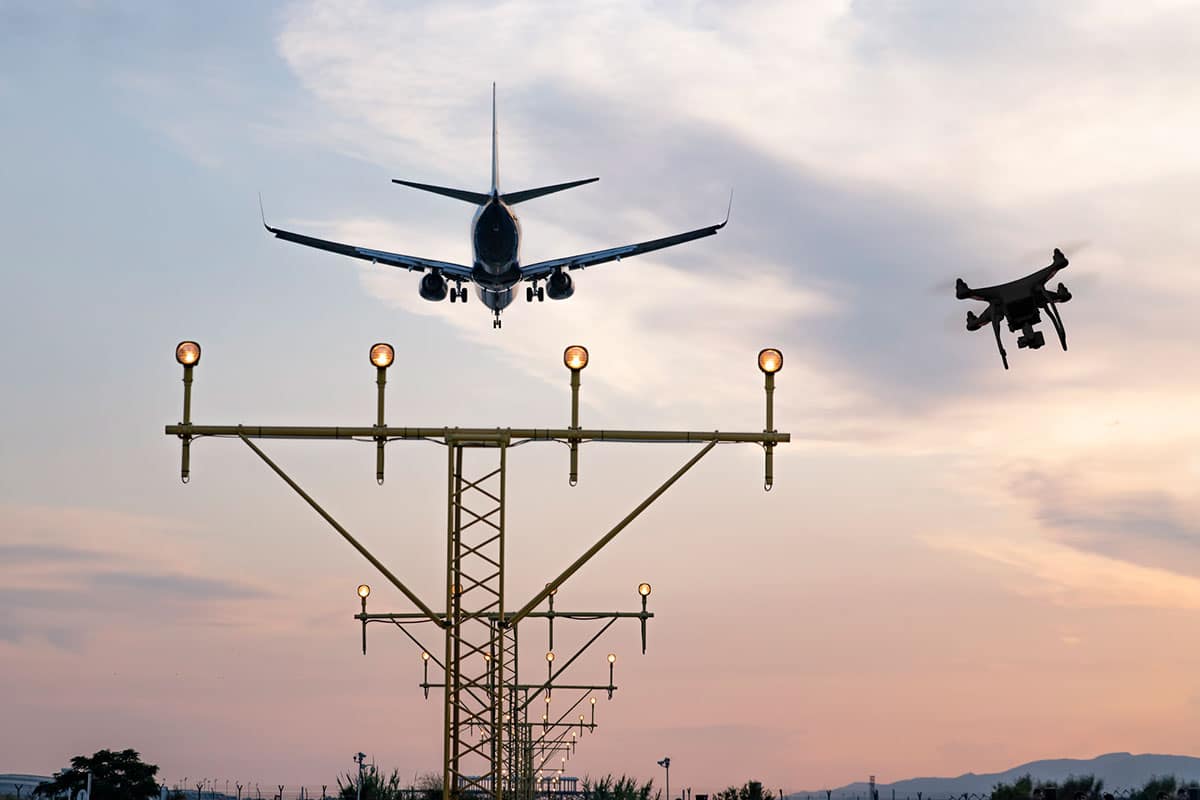
Researchers have developed a new way to accurately count and objectively analyze close encounters between drones and airplanes — without depending solely on pilot sightings.
In a peer-reviewed study published by the Society of Automotive Engineers in the “SAE International Journal of Aerospace,” researchers looked at more than 1.8 million piloted aircraft operations and nearly 460,000 flights by small-uncrewed aerial systems (sUAS) around Dallas-Fort Worth Airport, a major hub.
Between August 2018 and July 2021, researchers with Embry-Riddle Aeronautical University and Unmanned Robotic Systems Analysis (URSA) identified 24 near-midair collisions (NMACs) in which sUAS or “drones” came within 500 feet of piloted aircraft.
Given that most air carrier close calls happened within 1.5 miles of a runway approach or departure zone, researchers recommended extending the runway exclusion zone for drones at the ends of high-risk runways, from about 1 mile to 3.5 miles.
“That modification would provide enhanced protection for piloted aircraft operating at less than 500 feet above ground level during approach or departure,” said Ryan Wallace, associate professor of Aeronautical Science. “Typically, small uncrewed aircraft don’t fly above 400 feet.”
Gathering Objective Evidence
Up to this point, information about narrow escapes between sUAS and airplanes has been based on subjective reports from pilots who must simultaneously identify and evade drones in the air. Existing information does not include sUAS not spotted by pilots. Yet, the FAA received an alarming 2,596 pilot reports in 2021 — more than double the 1,210 reports during the first full calendar year of tracking in 2015.
Now, Embry-Riddle Aeronautical University researchers have devised an objective way to gather detailed information about NMACs between drones and airplanes.
They analyzed sUAS and aircraft telemetry data collected using an Unmanned Aerial System (UAS) detection device connected to an antenna atop Dallas-Fort Worth Airport’s busy Terminal C concourse. For each sUAS within a 30-mile radius, the device captured telemetry, altitude, launch location and other details.
Researchers combined that information with ADS-B (automatic dependent surveillance-broadcast), as well as Mode S messages transmitted by airplanes and tracked by the OpenSky Network. To better understand and visualize the resulting data, all information was fed into URSA’s Airspace Awareness Platform, or AAP-NMAC — a proprietary data analytics software.
“We hope that our findings will help improve aviation safety by reducing the risk of collisions between unmanned aircraft systems and piloted aircraft operating in the National Airspace System,” Wallace said.
Understanding Near-Miss Events
Over the nearly three-year study period, researchers detected 24 close-call events, including two in 2018, one in 2019, 14 in 2020 and seven in 2021. Across all of the NMACs, the mean lateral distance between the drone and the airplane was only about 215 feet. Commercial air carriers were involved in 11 NMACs, while seven incidents involved helicopters and six involved general aviation aircraft.
All of the helicopter encounters happened within 1.25 miles of a heliport. Similarly, in 10 of the 11 air carrier encounters, the aircraft was within 1.5 miles of approach or departure and lower than 500 feet above the ground.
“Operations within the vicinity of an airport are critical flight phases for pilots with high workload levels. It is within these areas where aircraft have added susceptibly of a collision with sUAS,” said Scott Winter, associate professor of Graduate Studies and associate dean for research, who was a co-author of the research article. “The findings from this study provide objective data for operators, government agencies and airlines to understand sUAS operations better and prevent possible conflicts.”
As of 2020, an estimated 1.46 million sUAS were operating in the National Airspace System, the FAA has reported. By 2025, the FAA predicts the small uncrewed aircraft systems (sUAS) fleet will include nearly 2.4 million units.
“The proliferation of drones, particularly ones available to the general public, poses obvious risks,” said research collaborator and professor of Human Factors Dr. Stephen Rice. “Unfortunately, not all drone operators are responsible, knowledgeable or safety-minded. Many of them are not even aware of the rules they must follow.”
Of the 24 NMACs identified by Embry-Riddle researchers, Rice noted, the same three sUAS were responsible for more than half (13) of the encounters. Further, in 96% of the cases (23), the drone was operating in excess of the maximum permissible altitude for that area.
Though rare, NMACs between drones and piloted aircraft have happened. On Sept. 18, 2020, a Los Angeles police helicopter hit a drone, requiring an emergency landing. A second helicopter-sUAS collision over Los Angeles had been reported nine months earlier.
This fall, the FAA will implement a new requirement so that all drone operators will need a remote identification or RID signal to enhance safety and security. For those drone operators who comply with the requirement, Wallace noted, “RID signals should further enhance objective information about near-miss encounters between drones and airplanes.”

